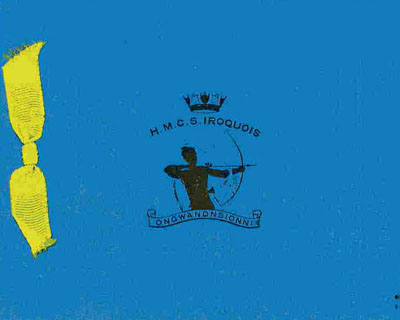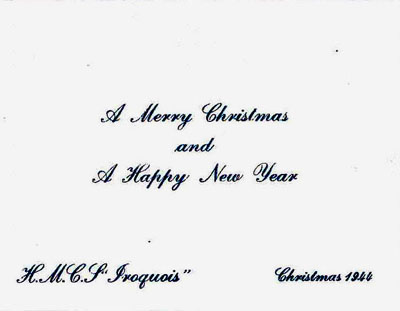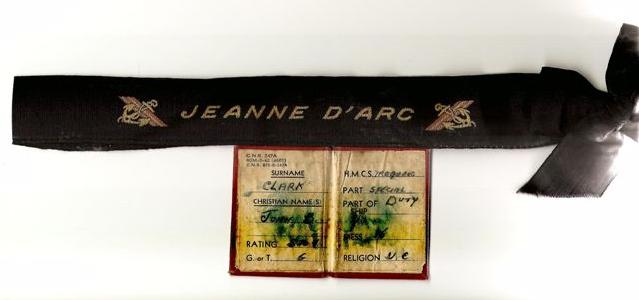![]()
![]()
 |
 |
| The ship's Christmas card from 1944. (Courtesy Tom Ingham) |
 |
| V-E Day ribbon. (Image courtesy of Jim Dowell) |
This ribbon was issued by the Royal Canadian Navy in order establish Iroquois' position when WWII officially ended in Europe on May 8, 1945. The ship arrived in Scapa Flow, Scotland on May 6 after completing convoy duty from Russia. With the war over, she sailed for Rosyth, Scotland on May 11 in company with Canadian, British and Norwegian ships to share in the liberation of Scandinavia. Aboard HMS Devonshire, was Crown Prince Olav of Norway, returning to his country after being in exile for five years. During the festivities, Iroquois visited ports in Oslo, Copenhagen and Keil. When Iroquois finally arrived back in Halifax in company with HMCS Haida and HMCS Huron on June 10, 1945 all three ships received a rousing welcome. The highlight was a personal message from the Chief of Naval Staff, Vice-Admiral G.C. Jones who was on hand to greet the returning Tribals.
The spirit symbolized by the Tribals continues to live on in public memory. (Image courtesy of Tom Ingham) From 1942 to 1945, Canada issued a postage stamp depicting a Tribal on trials. It is commonly known that the ship depicted on the stamp is HMS Cossack but it is widely believed that it was supposed to represent HMCS Iroquois possibly Atrhabaskan. Laurie Farrington, a naval historian and writer provides this explanation for the stamp.
"It has been suggested the 1942 Canadian one dollar destroyer stamp was a Canadian Tribal Class destroyer, either HMCS Iroquois or Athabaskan. Indeed, one book Unlucky Lady: The Life and Death of HMCS Athabaskan 1940-44 by Len Burrow and Emile Beaudoin published in 1982 includes a photograph of the 1942 $1.00 stamp and describes it as Iroquois at speed. The construction of both Iroquois and Athabaskan began in 1940 in the United Kingdom and Iroquois was the first Canadian Tribal to be commissioned in late 1942. After air raids which damaged Iroquois, the unscathed Athabaskan was renamed Iroquois so that launching schedules could remain unchanged. It has been suggested that possibly the air raids, the resulting delays in construction and the interchange of names between Canada's first two Tribals may have precluded using one of them as the model for the stamp. The $1.00 stamp was issued 1 July, 1942, before either Iroquois or Athabaskan was commissioned, so one could not really expect a photograph of either ship was used as the model of the stamp. So which Tribal Class destroyer was used?
Research at the Canadian Postal Archives, National Archives of Canada, Ottawa, has confirmed that neither Iroquois (G89) , commissioned in November, 1942, nor Athabaskan ( G07), commissioned in February 1943, was depicted in the one dollar stamp. HMS Cossack served as the actual model for the one dollar stamp. According to researchers it had been the intention to use a Canadian Tribal Class destroyer in the new 1942 stamp series which reflected Canada's share in the war, with special emphasis on our armed forces, munitions, war supplies, ship-building and agriculture. However, a photograph of the Royal Navy destroyer HMS Cossack was chosen by the stamp artist. The ship's number L03 was that of Cossack which had been built in 1938 .
In February 1940 Cossack achieved fame by entering a Norwegian fiord to rescue British seamen (from ships sunk by the Admiral Graf Spee) held prisoner m the supply ship Altmark. In April she was involved in the second Battle of Narvik and in May the destruction of the Bismarck. Finally, on 11 November 1941 the Cossack was torpedoed and sunk in the Atlantic with heavy loss of her crew. Thus when the Canadian $1.00 stamp appeared on 1 July, 1942, the ship which provided the photograph model for the stamp had been sunk eight months earlier. Perhaps naval intelligence had proposed that Cossack should be resurrected in stamp form in 1942 to confuse the enemy".
(Image courtesy Ted Doyle) There used to be a type of competition, the morning after a night action, to see who could find the biggest piece and/or the most pieces of shrapnel on deck. The crew would turn these over to the Gunnery Officer who would attempt to identify the type of gun used. Afterwards, the shrapnel would be returned to the crew as souvenirs.
This felt pennant, about 6" x 21", was issued around 1945. (Image courtesy Ted Doyle)
This certificate was issued to all those who crossed the Arctic Circle. (Image courtesy Ted Doyle)
 |
| This was submitted by John Clark. "The cap ribbon is the one from the Free French cruiser of the same name. We escorted her into Cherbourg on Sept 5th ,1944, carrying the French Provisional Government returning to Paris from England . I got the ribbon from a FF Seaman in a trade. Below it, is my last Watch Card issued on IROQUOIS. The ink is blurred from rain or beer, I can't remember". |
Contributors and Credits:1) John Clark <johnbhclark(at)rogers.com>
Jan 8/10
To Memorabilia (2) Page